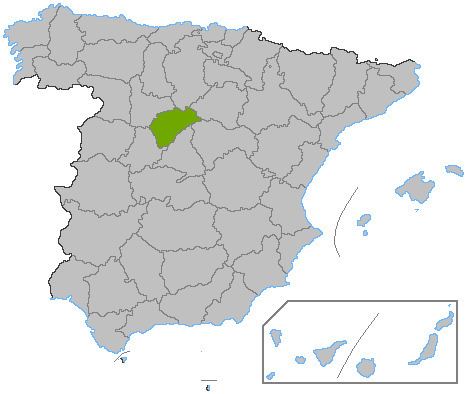 | ||
Segovia is one of the 52 electoral districts (circunscripciones) used for the Spanish Congress of Deputies - the lower chamber of the Spanish Parliament, the Cortes Generales. It is one of the nine electoral districts which correspond to the provinces of Castile and León. Segovia is the largest municipality accounting for around a third of the total electorate. It is the only municipality with more than 10,000 voters. Segovia was one of the relatively few districts where the electorate fell between 2000 and 2004. It is also one of the smallest districts in terms of electorate, ranking 47th out of the fifty two districts.
Contents
Boundaries and electoral system
Under Article 68 of the Spanish constitution the boundaries must be the same as the province of Segovia and under Article 140 this can only be altered with the approval of congress. Voting is on the basis of universal suffrage in a secret ballot. The electoral system used is closed list proportional representation with seats allocated using the D'Hondt method. Only lists which poll 3% or more of all valid votes cast, including votes "en blanco" i.e. for "none of the above" can be considered for seats. Under article 12 of the constitution, the minimum voting age is 18.
Electoral procedures
The laws regulating the conduct and administration of elections are laid out in detail in the 1985 electoral law. (Ley Orgánica del Régimen Electoral General.) Under this law, the elections in Segovia, as in other districts, are supervised by the Electoral Commission (Junta Electoral), a permanent body composed of eight Supreme Court judges and five political scientists or sociologists appointed by the Congress of Deputies. The Electoral commission is supported in its work by the Interior Ministry. On election day, polling stations are run by electoral boards which consist of groups of citizens selected by lottery.
The format of the ballot paper is designed by the Spanish state, however, the law allows political parties to produce and distribute their own ballot papers, either by mailing them to voters or by other means such as street distribution, provided that they comply with the official model. The government then covers the cost of all printed ballot papers. These must then be marked by voters, either in the polling station or outside the polling station and placed inside sealed envelopes which are then placed inside ballot boxes in the polling station. Following the close of polls, the ballots are then counted in each individual polling station in the presence of representatives of the political parties and candidates. The ballots are then immediately destroyed, with the exception of those considered invalid or challenged by the candidates' representatives, which are retained for further scrutiny. The result is that full recounts are impossible.
Eligibility
Article 67.3 of the Spanish Constitution prohibits dual membership of the Cortes and regional assemblies, meaning that candidates must resign from Regional Assemblies if elected. Article 70 also makes active judges, magistrates, public defenders, serving military personnel, active police officers and members of constitutional and electoral tribunals ineligible.
Number of members
Segovia has returned three members at every election since the restoration of democracy.
Under Spanish electoral law, all provinces are entitled to a minimum of 2 seats with a remaining 248 seats apportioned according to population. These laws are laid out in detail in the 1985 electoral law. (Ley Orgánica del Régimen Electoral General) The practical effect of this has been to overrepresent smaller provinces like Segovia at the expense of larger provinces. Segovia had a ratio of 41,546 voters per deputy in 2004 a figure far below the Spanish average of 98,777 voters per deputy. and the third smallest ratio of all after Teruel and Soria.
Summary of seats won 1977–2011
Seats shown for the Peoples Party include seats won by their predecessors the Popular Alliance in 1982 and the Popular Coalition in 1986.
Results
The parties of the right have topped the poll in every election since 1977 and Segovia was one of fifteen districts where the PP received an absolute majority by polling more than 50% in 2008.
2008 General Election
†On 22 April 2010, Merino Delgado was replaced by Sara Dueñas Herranz
*On 14 June 2011, López Águeda was replaced by Clara Luquero de Nicolás
2004 General Election
Source:
